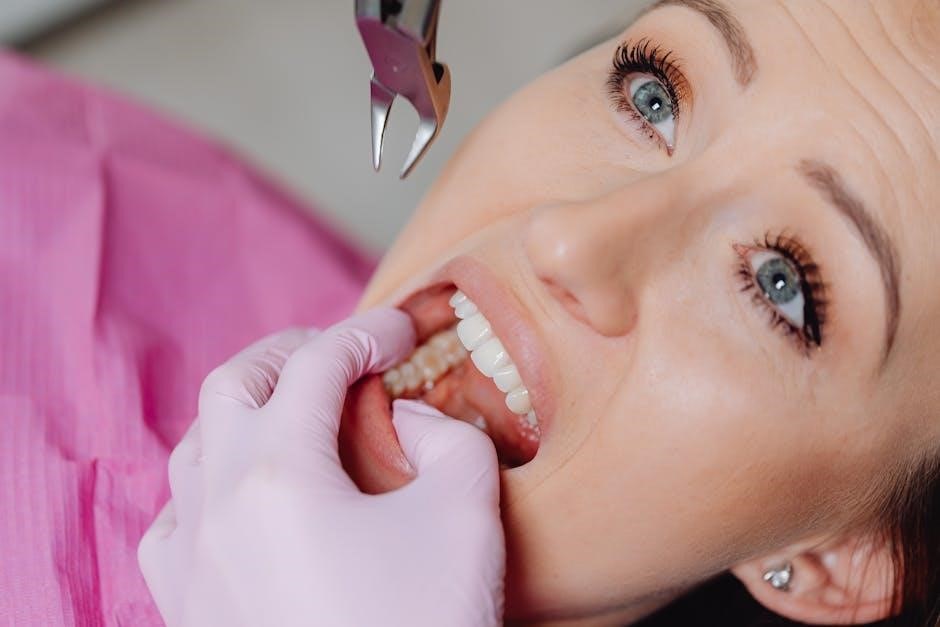Immediate Post-Operative Care
After tooth extraction, bite firmly on the gauze for 30 minutes to control bleeding. Avoid rinsing, spitting, or smoking for 24 hours to prevent dislodging the clot. Rest and avoid strenuous activities to promote healing and reduce swelling.
First 24 Hours After Tooth Extraction
The first 24 hours after tooth extraction are crucial for healing. Avoid rinsing, spitting, or smoking to protect the blood clot. Apply a cold compress to reduce swelling. Rest and avoid strenuous activities. Stick to a soft diet like yogurt, applesauce, or pudding. Do not drink through a straw or consume hot liquids. Light bleeding is normal, but if it persists, contact your dentist. Keep the extraction site clean by gently brushing your teeth, but avoid disturbing the surgical area. Follow your dentist’s instructions carefully to ensure proper healing and prevent complications like dry socket. Monitor your symptoms and seek medical attention if you experience severe pain, heavy bleeding, or swelling.
Managing Bleeding and Swelling
Bleeding and swelling are common after tooth extraction. To control bleeding, keep the gauze in place for 30-60 minutes. If bleeding persists, replace with a clean gauze or damp tea bag. Elevate your head while resting to reduce swelling. Apply a cold compress to the affected area for 15-20 minutes at a time during the first 24 hours. Avoid hot foods, drinks, or strenuous activities that could worsen bleeding or swelling. Monitor the color and consistency of the blood; if it becomes heavy or bright red, seek medical advice. Swelling typically peaks 36-48 hours post-surgery and subsides within a few days. Follow your dentist’s guidelines to minimize discomfort and ensure proper healing.

Day 1-2 Recovery Guidelines
Resume normal activities gradually. Stick to soft foods, gentle brushing, and avoid disturbing the extraction site. Begin salt water rinses 24 hours post-surgery to aid healing.
Rest and Activity Level Recommendations
Rest is essential for healing. Avoid lying flat; elevate your head with pillows to reduce bleeding and swelling. Limit physical activity for 24-48 hours. Refrain from strenuous exercises, bending, or heavy lifting, as these can dislodge the blood clot. After the first day, resume light activities but avoid overexertion. Ensure adequate sleep to promote recovery. Avoid smoking or drinking through straws, as suction can disrupt the clot. Follow your dentist’s specific advice to prevent complications and ensure proper healing. Avoid vigorous movements that may disturb the extraction site. Prioritize comfort and take regular breaks to rest.
Diet and Nutrition Advice
Stick to soft, nutritious foods for the first 24-48 hours, such as yogurt, applesauce, and scrambled eggs. Avoid spicy, hot, or hard foods that may irritate the extraction site. Opt for liquids like smoothies or broths to stay hydrated and nourished. Gradually introduce softer foods like mashed potatoes or toast as healing progresses. Avoid using straws, as suction can dislodge the blood clot. Stay hydrated to support recovery, but avoid carbonated or alcoholic beverages for 24 hours. Choose foods rich in vitamins and minerals to promote healing. Avoid chewy or sticky foods that could disrupt the clot. Plan meals in advance to ensure a smooth recovery.

Pain and Discomfort Management
Manage pain with prescribed medications, over-the-counter pain relievers, or applying a cold compress to reduce swelling. Follow dosage instructions carefully to ensure proper healing.
Over-the-Counter Pain Relief Options
Over-the-counter pain relievers like ibuprofen or acetaminophen can effectively manage discomfort after tooth extraction. Ibuprofen reduces inflammation, while acetaminophen is gentler on the stomach. Always follow recommended dosages and consult your dentist if pain persists or worsens. Avoid smoking or using straws, as they can dislodge the clot. Applying a cold compress to the swollen area can also help alleviate pain and swelling. If pain becomes severe or unbearable, seek medical attention to rule out complications like dry socket. Proper pain management ensures a smoother recovery and prevents unnecessary discomfort.
When to Seek Medical Attention
If you experience heavy bleeding that doesn’t stop with pressure, severe pain unrelieved by medication, or increasing swelling, seek immediate medical care. Other concerning symptoms include fever, difficulty opening your mouth, or a foul taste. If the extraction site becomes infected or you notice white or yellow tissue in the socket, contact your dentist. Persistent numbness or tingling, especially in the tongue or lips, may indicate nerve damage. If bleeding soaks through more than three gauze pads in an hour or you have trouble breathing, go to the emergency room. Don’t delay seeking help if recovery seems abnormal or complications arise.

Oral Hygiene Post-Extraction
After 24 hours, gently brush teeth with a soft brush and rinse with warm salt water. Avoid vigorous spitting or rinsing to protect the healing site.
Gentle Brushing and Rinsing Techniques
Start brushing gently 24 hours after extraction, using a soft-bristled toothbrush. Avoid the extraction site but clean surrounding teeth normally. For rinsing, mix 1 teaspoon of salt in 8 ounces of warm water. Gently swish the solution around your mouth, especially near the extraction site, after meals. Do not spit forcefully, as this could dislodge the clot. Continue this routine for 3-4 days or as advised by your dentist. This helps maintain oral hygiene without interfering with the healing process.

Swelling and Bruising Care
Apply a cold compress to the affected area for 15-20 minutes to reduce swelling. Elevate your head while resting to minimize bruising and swelling. Repeat as needed.
Using Cold Compresses Effectively
To reduce swelling and bruising after tooth extraction, apply a cold compress or ice pack to the affected area for 15-20 minutes at a time. Repeat this process several times a day, especially within the first 48 hours, as swelling typically peaks during this period. Ensure the compress is wrapped in a cloth to avoid direct contact with the skin, preventing ice burns. Continue this practice as needed to alleviate discomfort and promote healing. This method is most effective when started immediately after the procedure and maintained consistently during the initial recovery phase.

Complications to Watch For

Monitor for signs of dry socket, infection, or excessive bleeding. Contact your dentist if severe pain, swelling, or an empty socket persists. Early intervention is crucial.
Dry Socket Prevention and Treatment

Dry socket occurs when the blood clot dislodges, exposing the bone and nerve. To prevent it, avoid smoking, rinsing vigorously, or using straws for 24-48 hours. Gently brush around the area and rinse with warm salt water after meals. If a dry socket develops, apply medicated dressings or gels as directed by your dentist. Over-the-counter pain relievers can help manage discomfort. If pain persists or worsens, seek immediate medical attention to prevent infection and promote healing. Proper care ensures the socket heals smoothly, reducing the risk of complications and promoting a faster recovery.
